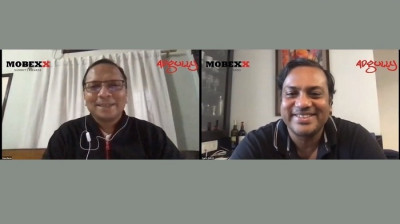Understanding digital advertising’s tryst in the digitised world
As per GroupM’s ‘This Year Next Year: Global 2020’ report, digital advertising is expected to grow by 8.2 per cent during 2020. The report estimates that by 2024, digital advertising will have a 66 per cent share globally.
Even as digital is growing by leaps and bounds in India, especially with the massive digital transformation see when COVID-19 struck and the entire country was confined indoors due to the lockdown, it will be an error to write off traditional media, which is seeing a rebound as the economy keeps opening up.
The special fireside chat on ‘Mind Over Matter - Digital Advertising’s Tryst in the Digitized World’, held on Day 2 of MOBEXX 2020, brought together two sharp minds of the industry – Rana Barua, Group CEO, Havas Media Group, who was in conversation with Gourav Rakshit, COO, Viacom18 Digital Ventures.
The efficacy of any medium is judged by the RoI that it delivers. As an extremely dynamic space, digital has allowed advertisers to find new ways to reach out to the end consumer and mobile being an extremely personal device, even find personalised ways of reaching out to the consumers.
As digital penetration further increases in the country, even the reach is only working for the better of advertisers and brands as ROI becomes more measurable in the digital space. However, the debate on Print RoI versus TV RoI vs Digital RoI is one that seems never ending.
Barua observed that “while we can see a very clear and detailed RoI for digital advertising, yet it faces stiff competition from traditional media such as TV and print and we keep questioning and debating digital’s RoI.” He sought Rakshit’s views on this debate, who responded by saying, “The large macro-economic reality that I see which is in the streaming space is that attention is moving to streaming and that’s not going to go away. Advertising is perhaps the grease that makes this engine go in terms of how you capitalise on that attention in a way that is valuable for brands and is not disruptive for consumers.”
Rakshit further said that having seen the shift across media, one of the challenges that one faces when one moves from traditional forms of media to digital to some sense is the curse of RoI. “Most good advertisers have a sense of where their money goes and what their money delivers, even in traditional media. Digital allows you to have a more tactile feel in terms of consumer behaviour. What that performance means at an aggregate level, where you are dealing with CTRs, etc., it goes back to area of being able to understand your user,” he added.
According to Rakshit, another challenge is that while there is centralised measurement of traditional media and broadly everyone agrees that this is the metric that we will judge the exposure by, in digital media it is harder because we as publishers know our metrics intimately and so it’s much harder for a third party to provide a central data score which is very easy to controvert because we know our own numbers.
He observed, “So, some of these things we will have to understand and accept as being the way of the future because the existence of video on demand makes it much harder for a central agency to track than when there is a limited amount of content out there. Given the width of content available, that is a very staggering challenge as it is very difficult to know where your ads are running unless you put stock in a publisher or a group of publishers, because there is no way for you to actually “know”.”
Rakshit saw some of these challenges shaping the industry of the future. “My view is that as soon as you find consumer attention moving in a particular way, people will figure it out; it’s just that people are figuring out their lens on this.”
Catch the complete conversation below:




Share
Facebook
YouTube
Tweet
Twitter
LinkedIn